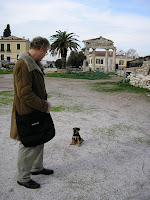 |
| The Isthmus of Corinth |
In the late morning we go to the National Archaeological Museum. It is full of the Greek masterpieces I studied at Cambridge when I was doing my degree in Classical Archaeology. Again I am struck by how many of these beautiful white sculptures or grave steles had traces of bright paint on them! We have arranged for an English-speaking taxi driver to pick us up outside the Museum at a certain time and he is there. His name is Stavros. His family comes from Crete but he is now an Athenian.
 |
| Sanctuary of Corinth |
At Corinth we whizz through the site in 15 minutes and skip the Acrocorinth. I was there many years ago and will never forget the magic of the place. You hear nothing but the wind and bees and maybe the clank of a flock of goats moving down the hill. And I still remember hearing the distant braying of a donkey from miles away on the plain. I'd love to take Richard there but we don't have time. It will have to wait.
 |
| Stavros in Lechaeum, Corinth |
 |
| Helen's Bath? |
It is my idea that Flavia and her friends are staying here a mile or two from Cenchrea in a luxury guest house called Helen's Hospitium. Helen is a beautiful Greek widow who owns the hospitium and has designs on Flavia's father, Captain Geminus. As my husband Richard says, Captain Geminus isn't so much a babe-magnet as a matron-magnet. Well, he does still have all his teeth!
 |
| ruins of Cenchrea, Corinth |
After Helen's Baths we find the site of Cenchrea. A marble pillar and some clay tiles are fenced off and when I climb a brambly hillock I can see the remains of stone piers going out into the water.
We are an hour behind schedule and I want to take the coast road along the Isthmus – the road Theseus travelled when he first went to Athens to claim his birthright. We find Sciron's Rock but not the Evil Stairs. Later I read in the Blue Guide that the ancient road was much higher.
 |
| shrine on the Isthmus of Corinth |
Finally at dusk we reach Eleusis. All the guide books say it's an ugly industrial area and yes, there are too many huge factories and refineries on this lovely stretch of coast, but Eleusis itself has some charming seaside cafes by the ruins. I didn't realise it was this close to the water. I didn't realise that conical needle of rock was so dramatic. Of course it's not open but I can peer through the fence and see the columns and blocks of marble and even the Cave of Pluto. There is always a cave.
Eleusis was of course the sanctuary of Demeter and site of the famous Eleusinian Mysteries. The Mysteries were so mysterious that nobody to this day knows exactly what went on there. It's getting dark now and so we turn back onto the motorway and go home.
 |
| Fagopoteion in Athens Kolonaki |
[The 17+ books in the Roman Mysteries series, including The Fugitive from Corinth, are perfect for children aged 9+, especially those studying Romans and/or Greeks as a topic in Key Stages 2 and 3. There are DVDs of some of the books.]





















